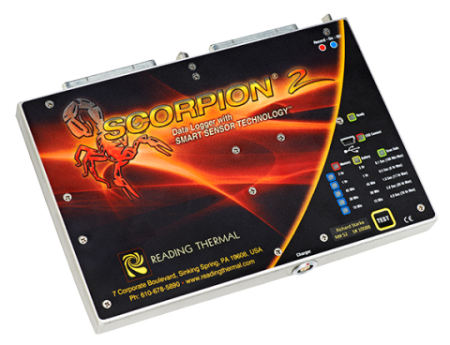If your industrial bakery oven experiences inconsistent product quality, moisture retention, uneven bakes, or low production capacity, oven data loggers from Reading Thermal may be just the solution your need to identify and correct the problem.
Reading Thermal, headquartered in Sinking Spring, Pennsylvania, has been focused on measuring and understanding the commercial baking process for more than 25 years. We manufacture and support the SCORPION® 2 Profiling System which has become a standard in the baking industry.
The SCORPION® 2 enables you to monitor actual in-process conditions and get the critical information you need to correct problems and maintain optimum process control. This powerful diagnostic tool has become an industry standard for understanding and improving your proofing, baking, cooling and freezing processes.
Measuring Baking Parameters
The SCORPION® 2 is designed to measure temperature and other baking parameters at product level, in fixed positions across the conveyor, and deliver a true representation of what your product is experiencing over time.
1) Temperature: Oven temperature causes physical and chemical reactions in dough/batter. Insufficient or excessive temperature during baking can lead to changes in fermentation and humidity levels, as well as undesirable changes in color, texture and taste. The Scorpion® 2 Temperature Sensor Array is designed to measure temperature at product level, in fixed positions across the conveyor, and delivers a true representation of what the product experiences over time.
2) Heat flux: Oven heat flux is the amount of energy transferred per unit area per unit time from or to a surface. It is the best indicator of oven performance during baking in terms of the product. Many bakers use oven heat flux profiles when attempting to produce the same product on two different lines or when trying to transfer product from one line to another. The two lines will produce the same product when the heat flux profiles match. The SCORPION® 2 Heat Flux Sensor is designed to measure convective and radiant heat fluxes at product level and display the results in Btu/hr·ft2 or W/m2.
3) Air velocity: In a radiant oven, the airflow comes from the moving conveyor, the exhaust system, and natural combustion air currents. In a convection oven, the airflow comes primarily from the air distribution plenums. Measuring the oven air velocity with the SCORPION® 2 Air Velocity Sensor is critical because airflow influences the coloration, texture, firmness, and baking time of the final product. The profiles will help you spot airflow differences between baking zones and unwanted air currents at the entrance or exit of the oven that result in inconsistent baking.
4) Humidity: Oven humidity is a measurement of the moisture in the air. The moisture often comes from the product itself and represents a delicate balance that affects finished product quality in many ways; e.g., the amount of moisture left in a pretzel can determine its shelf life, while reduced evaporation can keep the surface of a cookie moist, allowing it to stretch, preventing cracks. The SCORPION® 2 Humidity Sensor is designed to measure the absolute moisture content of the thermal environment in both your heating and cooling processes.
Reading Thermal offers different types of pluggable sensors, including one designed for solid or tight mesh conveyors and one for open mesh conveyors.
Call the Reading Thermal headquarters in Sinking Spring, Pennsylvania at (610) 678-5890 Ext. 2, or contact us online to learn more about our state-of-the-art data loggers for your industrial bakery oven.

